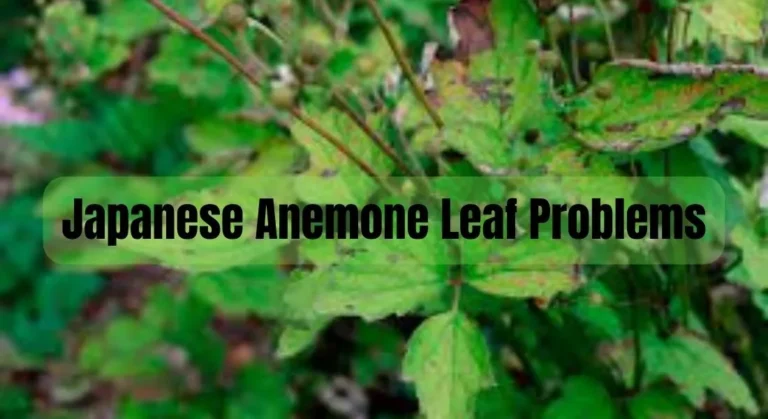Trouble in the Garden: Potted Acer Tree Problems and How to Solve Them
From Louise: Passionate about gardening, I specialize in plant care and flower knowledge. I’m here to share my expertise and assist with your gardening queries. Feel free to ask any questions or seek advice on lawn care—I’ll respond within 24 hours!
Experiencing issues with your potted Acer tree? You’re not alone. Acer trees, known for their vibrant foliage and delicate leaves, can be finicky in pots.
This condition turns leaves brown, curls them, and causes them to shrivel, making your tree appear unhealthy. Leaf scorch can result from factors like excessive sunlight, insufficient water, poor soil quality, pests, or diseases. We’ll delve into its causes and prevention for your Acer tree.
In this article, we’ll address common potted Acer tree problems, starting with leaf scorch.

Potted Acer Tree Problems
If you’re a fan of Acer trees, you might want to consider growing one in a pot. It’s a great way to enjoy the beauty of these trees even if you have limited space.
However, potted Acer trees can experience several problems that can affect their health and appearance. Here are some of the most common potted Acer tree problems, along with tips on how to prevent and fix them.
Leaf Drop
One of the most common problems with potted Acer trees is leaf drop. Acer trees may start losing their leaves due to several reasons. Overwatering or underwatering is a common cause of leaf drop. Poor drainage can also cause the roots to rot, leading to leaf drop.
Environmental stress, such as sudden temperature changes or strong winds, can also cause your Acer tree to shed its leaves. To prevent leaf drop, make sure your Acer tree is getting the right amount of water and that the soil is well-draining. Avoid exposing your tree to extreme temperatures and strong winds.
Leaf Scorch
Another common problem with potted Acer trees is leaf scorch. This is a condition where the leaves of the tree start to brown, curl up, or shrivel. Leaf scorch is often caused by exposure to direct sunlight or hot, dry winds.
To prevent leaf scorch, make sure your Acer tree is in a shaded area and protected from strong winds. You can also use a shade cloth or umbrella to protect your tree from direct sunlight.
Pest Infestations
Potted Acer trees are also susceptible to pest infestations. Common pests that can affect Acer trees include aphids, scale insects, and spider mites. These pests can cause damage to the leaves and stems of your tree, affecting its overall health.
To prevent pest infestations, regularly inspect your Acer tree for signs of pests. You can also use insecticidal soap or neem oil to control pest populations.
Root Rot
Root rot is a common problem with potted Acer trees. This is a condition where the roots of the tree start to rot due to overwatering or poor drainage. Root rot can cause your Acer tree to wilt, lose leaves, and eventually die.
To prevent root rot, make sure your Acer tree is planted in well-draining soil and that the pot has drainage holes. Water your tree only when the soil is dry to the touch.
Improper Nutrient Supply
Lastly, potted Acer trees can experience problems due to improper nutrient supply. Acer trees require certain nutrients to grow and thrive, and without them, they can become weak and susceptible to disease.
To prevent nutrient deficiencies, make sure your Acer tree is getting the right amount of fertilizer. Use a slow-release fertilizer that is specifically formulated for Acer trees, and follow the instructions carefully.
Overall, growing a potted Acer tree can be a rewarding experience. However, it’s important to be aware of the potential problems that can affect your tree’s health. By following these tips, you can keep your Acer tree healthy and beautiful for years to come.
Identifying Common Problems
If you’re a proud owner of a potted Acer tree, you may have noticed some issues with your plant. Identifying the problem is the first step towards finding a solution. Here are some common problems that you may encounter with your potted Acer tree:
Wilting
If you notice that your Acer tree is wilting, this could be a sign of water stress or root rot. Overwatering or underwatering can lead to root rot, which affects the ability of the tree to absorb water and nutrients.
Pest infestation and disease can also cause your Acer tree to wilt. To prevent wilting, make sure to water your tree properly and regularly. Check the soil moisture level regularly to ensure that it’s not too dry or too wet.
Leaf Scorch
Leaf scorch is a condition where the leaves of your Acer tree turn brown or yellow around the edges. This is most likely caused by excessive exposure to dry winds, direct sunlight in the hot summer, or frost in the winter.
Also, excessive watering doesn’t do any favors to your potted Acer tree, either, as this type of plant doesn’t thrive in waterlogged soils.
To prevent leaf scorch, make sure to plant your Acer tree in a location that provides some shade during the hottest part of the day and keep the soil moist but not waterlogged.
Pest Infestation
Pest infestation is another common problem that can affect your potted Acer tree. Aphids, spider mites, and scale insects are some of the most common pests that can infest your Acer tree.
These pests can cause damage to the leaves and stems of your tree, which can lead to wilting and other problems.
To prevent pest infestation, make sure to keep your Acer tree healthy and well-maintained. Regularly inspect your tree for signs of infestation and treat it promptly if you notice any problems.
Disease
Disease is another problem that can affect your potted Acer tree. Verticillium wilt, leaf spot, and powdery mildew are some of the most common diseases that can affect your Acer tree.
These diseases can cause damage to the leaves and stems of your tree, which can lead to wilting and other problems. To prevent disease, make sure to keep your Acer tree healthy and well-maintained. Regularly inspect your tree for signs of disease and treat it promptly if you notice any problems.
Preventing Diseases and Pests
One of the most important things you can do to keep your potted Acer tree healthy is to prevent diseases and pests. Here are some tips to help you do just that.
Proper Watering
Acer trees need to be watered properly to prevent diseases and pests. Make sure the soil is moist, but not waterlogged. Overwatering can lead to root rot, which can be fatal for your tree. On the other hand, underwatering can cause stress and make your tree more susceptible to diseases and pests.
To ensure proper watering, check the soil regularly. If it feels dry, it’s time to water your tree. When you do water, make sure you water deeply. This will encourage roots to grow deep into the soil, making your tree more resilient.
Correct Soil Mix
Using the correct soil mix is also important for preventing diseases and pests. Acer trees prefer well-draining soil that is rich in organic matter. This helps to ensure that the roots get the nutrients they need to grow strong and healthy.
When choosing a soil mix, look for one that is specifically designed for Acer trees. This will help to ensure that the pH balance is correct and that the soil is well-draining. You can also add compost or other organic matter to the soil to help improve its quality.
Adequate Sunlight
Acer trees need adequate sunlight to thrive. They prefer partial shade, but can also tolerate full sun. If your tree is not getting enough sunlight, it can become stressed and more susceptible to diseases and pests.
To ensure your tree is getting enough sunlight, place it in a location where it will receive at least 4-6 hours of direct sunlight per day. If your tree is not getting enough sunlight, consider moving it to a new location or pruning nearby trees or shrubs to allow more light to reach your tree.
By following these tips, you can help prevent diseases and pests from damaging your potted Acer tree. Proper watering, correct soil mix, and adequate sunlight are all essential for keeping your tree healthy and strong.
Dealing with Pests
Pests are one of the most common problems that Acer trees face, and if not dealt with properly, they can cause severe damage to the plant. Here are some of the most common pests that can infest your Acer tree and how to deal with them.
Aphids
Aphids are small insects that feed on the sap of the plant, causing the leaves to curl and yellow. They are usually found on the undersides of the leaves and can reproduce rapidly. To get rid of aphids, you can:
- Spray the tree with a strong jet of water to knock them off
- Apply insecticidal soap or neem oil
- Introduce natural predators such as ladybugs or lacewings
It is important to act quickly when dealing with aphids as they can quickly spread to other plants in your garden.
Scale Insects
Scale insects are small, oval-shaped insects that attach themselves to the stems and leaves of the tree. They feed on the sap of the plant and can cause yellowing and stunted growth. To get rid of scale insects, you can:
- Prune the affected branches and leaves
- Apply horticultural oil to suffocate the insects
- Introduce natural predators such as ladybugs or parasitic wasps
It is important to monitor your Acer tree regularly for signs of scale insects as they can quickly spread to other plants in your garden.
Remember, prevention is always better than cure, so make sure to keep your Acer tree healthy by providing it with the right amount of water, nutrients, and sunlight. Regularly inspect your tree for signs of pests and act quickly to prevent them from causing any damage.
Addressing Diseases
When it comes to potted Acer trees, diseases can be a major issue. In this section, we will discuss two common diseases that can affect your tree: Verticillium Wilt and Phytophthora Root Rot.
Verticillium Wilt
Verticillium Wilt is a fungal disease that can cause wilting, yellowing, and death of your Acer tree. The fungus enters the tree through the roots and spreads throughout the tree’s vascular system. This disease is most common in warm, dry weather.
If you notice symptoms of Verticillium Wilt, such as wilting or yellowing leaves, it is important to act quickly. Here are some steps you can take to address this disease:
- Remove infected branches: If you notice that some branches are infected, remove them immediately to prevent the disease from spreading.
- Improve soil drainage: Verticillium Wilt thrives in wet soil, so improving drainage can help prevent the disease from spreading.
- Apply fungicide: A fungicide can help control the spread of Verticillium Wilt. Be sure to follow the instructions on the label carefully.
Phytophthora Root Rot
Phytophthora Root Rot is a soil-borne disease that can cause root rot, wilting, and death of your Acer tree. This disease is most common in wet soil and can be caused by overwatering.
If you notice symptoms of Phytophthora Root Rot, such as wilting or yellowing leaves, it is important to act quickly. Here are some steps you can take to address this disease:
- Improve soil drainage: Phytophthora Root Rot thrives in wet soil, so improving drainage can help prevent the disease from spreading.
- Reduce watering: Overwatering can cause Phytophthora Root Rot, so reducing watering can help prevent the disease from spreading.
- Apply fungicide: A fungicide can help control the spread of Phytophthora Root Rot. Be sure to follow the instructions on the label carefully.
By taking these steps, you can help address these common diseases and keep your potted Acer tree healthy.
Reviving a Sick Acer Tree
If your potted acer tree is showing signs of distress, there are steps you can take to revive it. With proper care and attention, your acer tree can recover and thrive.
Pruning Techniques
One way to revive a sick acer tree is through pruning. Pruning dead or diseased branches can help the tree focus its energy on healthy growth. Here are some pruning techniques to consider:
- Deadheading: Remove dead flowers and buds to encourage new growth.
- Thinning: Remove overcrowded branches to allow for better air circulation and light penetration.
- Selective pruning: Remove damaged or diseased branches to prevent further spread of the problem.
When pruning your acer tree, be sure to use sharp, clean tools to avoid damaging the tree further. Cut branches at a 45-degree angle just above a healthy bud or branch.
Repotting Tips
Another way to help revive a sick acer tree is through repotting. Repotting can help refresh the soil and provide new nutrients for the tree. Here are some tips for repotting your acer tree:
- Choose the right pot: Select a pot that is slightly larger than the current one to allow for growth. Make sure the pot has drainage holes to prevent waterlogging.
- Use fresh soil: Use a high-quality potting mix that is rich in nutrients and has good drainage.
- Trim the roots: Trim any damaged or rotting roots before repotting to prevent further spread of the problem.
- Water properly: Water the tree thoroughly after repotting and then only when the top inch of soil feels dry to the touch.
By following these tips, you can help revive your sick acer tree and promote healthy growth. Remember to monitor your tree regularly and address any issues promptly to prevent further damage.
Frequently Asked Questions (FAQs)
How often should I water my potted Acer tree?
You should water your potted Acer tree when the top inch of soil feels dry to the touch. Use well-draining soil and a pot with drainage holes to prevent waterlogging.
What kind of fertilizer should I use for my potted Acer tree?
You can use a balanced fertilizer, such as a 10-10-10 or 20-20-20 fertilizer, to provide essential nutrients to your potted Acer tree. Use slow-release fertilizers to provide a steady supply of nutrients to the tree.
How do I prune my potted Acer tree?
You should prune your potted Acer tree in late winter or early spring, before new growth begins. Use sharp, clean pruning shears and make clean cuts at a 45-degree angle. Remove dead, diseased, or damaged branches, and thin out crowded branches to improve air circulation.
Conclusion
Potted acer tree problems are common, but they are also treatable. By identifying the problem and taking the necessary steps to fix it, you can keep your tree healthy and thriving for years to come. Remember to always pay attention to the needs of your tree, and don’t hesitate to seek help from a professional if necessary.
In summary, to keep your potted Acer tree healthy:
- Water your tree correctly
- Check the drainage
- Provide a stable environment
- Treat pest infestations and diseases promptly
- Adjust your fertilizer use if necessary
With a little care and attention, your acer tree can be a beautiful addition to your indoor or outdoor space. Happy gardening!
Related Posts:






